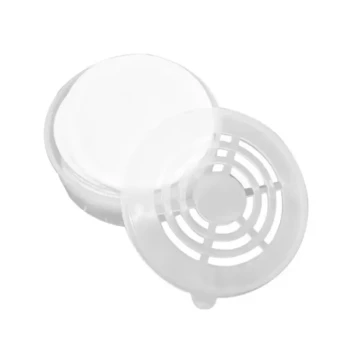The primary purpose of beekeeping gear is to provide personal protection for the beekeeper, creating a safe barrier against bee stings. While the term "hive head" is not standard, it likely refers to the most critical part of this gear: the helmet and veil that protect the beekeeper's head and face from the colony's natural defensive behaviors.
The core function of bee gear is not to control the hive, but to protect the beekeeper. This protection allows for calm, safe, and effective hive management, turning a potentially dangerous interaction into a productive one.

Deconstructing Beekeeping Gear: A System of Protection
Beekeeping gear is a system of specialized clothing designed to prevent stings. Each component serves a specific purpose, working together to ensure the beekeeper's safety and confidence.
The Critical Role of Head and Face Protection
The helmet and veil are arguably the most essential pieces of protective gear. Stings to the face, neck, and eyes are particularly dangerous and painful.
A beekeeping veil provides a screen that keeps bees away from the face while maintaining visibility. It is typically attached to a helmet or a specialized hat to hold it securely in place and away from the skin.
Comprehensive Body Coverage
Beyond the head, beekeepers use several other pieces of equipment to achieve full-body protection.
This includes specialized jackets or full-body suits made of thick, light-colored fabric that bees are less likely to perceive as a threat. Gloves made of leather or durable rubber protect the hands, which are in constant proximity to the bees.
Correcting the "Hive Head" Misconception
The term "hive head" is not used in standard beekeeping terminology. It is likely a misnomer for the helmet and veil combination—the "head" part of the "gear."
Crucially, this protective clothing is distinct from the tool used to calm bees.
Clarifying the Role of Smoke: A Separate Tool
The idea that gear "numbs the bees with smoke" confuses two different pieces of equipment: protective clothing and the bee smoker.
What is a Bee Smoker?
A bee smoker is a separate, handheld device that generates cool, thick smoke. The beekeeper gently puffs this smoke into and around the hive before and during an inspection.
How Smoke Actually Works
Smoke does not "numb" the bees. Instead, it interrupts their defensive communication and triggers a natural survival instinct.
First, the smoke masks the alarm pheromones that guard bees release when they perceive a threat. This prevents a distress signal from spreading and escalating into a full-scale defensive attack from the colony.
Second, smoke initiates a feeding response. The bees believe their home may be on fire and begin gorging on honey in case they need to abandon the hive. A bee with a full stomach is physically less able to flex its abdomen to sting and is generally more docile.
Understanding the Trade-offs in Gear Selection
Choosing the right gear involves balancing complete protection with comfort and maneuverability. There is no single perfect solution for every beekeeper or every situation.
Safety vs. Dexterity
Thick leather gloves offer maximum protection from stings. However, they significantly reduce a beekeeper's sense of touch and dexterity, making it harder to handle delicate frames of honeycomb and potentially leading to accidental harm to the bees.
Protection vs. Comfort
A full, ventilated bee suit provides the most comprehensive defense against stings. The downside is that these suits can be very hot and cumbersome, especially in warm climates, which can lead to beekeeper fatigue and dehydration.
Making the Right Choice for Your Goal
Selecting the right combination of gear depends entirely on your experience level, the temperament of your bees, and the task at hand.
- If your primary focus is maximum safety as a beginner: Opt for a full, light-colored, ventilated bee suit with durable gloves to build your confidence.
- If your primary focus is quick inspections as an experienced beekeeper: A simple jacket-and-veil combination may offer sufficient protection while being easier to put on.
- If your primary focus is managing a defensive colony: Your smoker is your most important tool for calming the bees, used in conjunction with your most comprehensive protective gear.
Ultimately, the right equipment empowers you to work with your bees calmly and respectfully, ensuring the well-being of both the keeper and the colony.
Summary Table:
| Component | Primary Purpose | Key Consideration |
|---|---|---|
| Helmet & Veil | Protects head, face, and neck from stings. | Essential for preventing dangerous and painful stings. |
| Jacket/Suit | Provides full-body coverage with thick, light-colored fabric. | Balances protection with comfort and heat management. |
| Gloves | Shields hands from stings during close work. | Trade-off between maximum protection and manual dexterity. |
| Smoker (Tool) | Calms bees by masking alarm pheromones; not part of the gear. | Aids in safe hive inspections but is separate from clothing. |
Equip your apiary with confidence. HONESTBEE supplies commercial apiaries and beekeeping equipment distributors with the high-quality, durable protective gear essential for safe and productive hive management. Our wholesale-focused operations ensure you get the reliable equipment your business depends on. Contact HONESTBEE today to discuss your bulk supply needs and enhance your beekeeping safety protocol.
Visual Guide

Related Products
- Wholesales Dadant Size Wooden Bee Hives for Beekeeping
- Yellow Plastic Bucket Pail Perch for Beekeeping
- Long Langstroth Style Horizontal Top Bar Hive for Wholesale
- Professional Insulated Winter Hive Wrap for Beekeeping
- Automatic Honey Flow Beehive 4 Frame Mini Hive for Beekeeping
People Also Ask
- What is the best place to keep bees? Find the Perfect Apiary Site for Your Hives
- What types of products are available for beekeeping needs? Essential Equipment for Apiaries & Distributors
- What is beekeeping equipment? Essential Tools for Commercial Apiaries & Distributors
- What should beginners consider when purchasing beekeeping equipment? A Guide to Essential Starter Gear
- What are the characteristics of oil-based paint for beehives? Durability vs. Modern Practicality



















